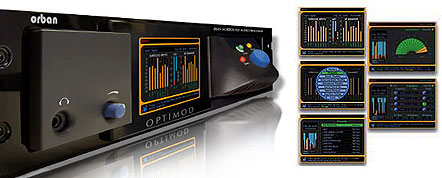
Optimod 8685 Surround — About (AC3) Metadata
There are three important pieces of metadata in the AC3 bitstream.
• Dialog Normalization, which in essence sets the receiver’s volume control to complement the dynamic range of the program material being transmitted.
• Line-Mode Dynamic Range Control, which allows the receiver to perform wideband dynamics compression if the listener chooses.
• RF-mode Dynamic Range Control, which applies more extreme compression.
When used correctly, these can help address the problem of inconsistent loudness between different sources while allowing viewers to individually choose the amount of dynamic compression they hear. However, experience so far has shown that the metadata implementation in the broadcast chain has often been too haphazard to prevent audience irritation.
Orban believes that the most realistic approach to handling AC3 dialog normalization is a hybrid approach. It is important to consider carefully what program material will truly benefit from the ability to be heard with unprocessed dynamic range. Prime-time dramatic shows, newer feature films, and classical music concerts all use dynamic range for dramatic impact and are therefore candidates for full exploitation of the AC3 DRC metadata.
Material that airs with full Dynamic Range Control implemented should be refined in production so that it sounds polished and consistent without further processing. Each show, film, and concert must have a dialog normalization value pre-assigned to it, derived from a long-term loudness meter or by human audition. It is probably impractical to pass through, without review, dialog normalization values created by program and commercial providers because some commercial providers will inevitably try to game the system to make their commercials excessively loud. Instead, if dialog normalization is to be actively used in transmission, the broadcaster must strip its existing value from the program and then must preview each piece of program material, replacing the value with one that will ensure consistency from one piece of program material to the next.
Even program segments whose Dialnorm value is set automatically according a long-term loudness measurement like ITU BS.1770 may still have short-term loudness peaks that are extremely annoying. Any program material that will not benefit from being heard with full dynamic range should be processed with the 8685 so that viewers can hear the audio comfortably. They should not be blasted by loud effects or commercials or being forced to strain to understand dialog. Most program material, including commercials, live news, sports, most documentaries, game shows, talk shows, soap operas, and pop music videos and concerts, can receive 8685 processing. The 8685 controls subjective loudness very well, so a single dialog normalization value can be applied to all program material whenever the 8685 is online. The advantage of this strategy is that the 8685 will guarantee that all of this material is comfortably listenable and that commercials are not excessively loud. With the possible exception of sport and some concerts, this program material does not rely on extreme dynamic range to make its point, so it is unlikely that compression will damage the artistic integrity of this programming.
No one needs more dynamic range on talk shows or on the local news. The 8685 can smoothly activate and defeat its dynamics processing on-air via GPI triggers or other remote control, so it is easy to implement this strategy.
Another important 8685 feature is “automatic re-equalization” of program material. The 8685’s multiband compressor can automatically re-equalize program material towards a preset target spectral balance by applying more gain reduction to frequency bands containing more power. The 8685’s compressor’s band coupling controls determine the maximum amount of re-equalization permitted.
In the two-band compressor, re-equalization controls excessive bass, which can otherwise cause muddy balances. The five-band compressor can perform more detailed automatic re-equalization, which can be particularly useful for program material such as live news and for any material where dialog intelligibility is a problem. Approximately 60% of digital OPTIMOD-TV users use two-band compression; the rest use five-band compression.
Dynamic range compression in Dolby Digital (using DRC metadata to achieve compression at the receiver) is a simple dynamic gain adjustment performed over the entire audio bandwidth; it does not do automatic re-equalization. The level detector determining the amount of DRC compression can be frequency-contoured to mimic the equal-loudness curves of the ear and has the ability to “look ahead” at upcoming program level changes. This is sufficient for many applications, but may be improved with the addition of a multiband device like the 8685 to handle certain programming that may not get sufficient treatment from a single-band device like that in DRC.
The 8685 can convey and process Dolby Digital metadata. See Conveying and Re-authoring Dolby Metadata in the Specifications section.
